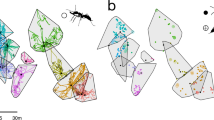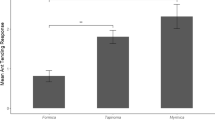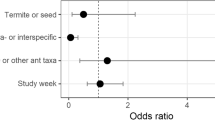Abstract
The arrival sequence of organisms in a habitat and their diet are two factors that are thought to modulate animal performance, affect the outcome of behavioural interactions, and shape communities. In New Zealand, two species that seldom co-occur in field populations are Prolasius advenus and Monomorium antarcticum. Herein we tested the hypotheses that arrival sequence and diet influence the strength of interactions between these two species. These ant species presented asymmetric responses to arrival sequence and diet variations. When arriving first P. advenus displayed increased aggression and M. antarcticum a defensive reaction. Changes in carbohydrate and protein availability modulated colony activity rates of both species. Colonies of M. antarcticum fed on a high carbohydrate and low protein diet displayed higher activity rates than colonies fed on a low carbohydrate and high protein diet. In contrast, control colonies of P. advenus fed on a high carbohydrate and low protein diet displayed lower activity rates than colonies fed on a low carbohydrate and high protein diet. These results indicate that arrival sequence can modulate the agonistic reaction displayed by interacting species in situations of conflict. This work also demonstrates that species adjust activity rates in response to diet, but different species do so differently. Therefore, arrival sequence and diet could explain species mutually exclusive distribution patterns observed in nature.




Similar content being viewed by others
References
Abrams P.A. 1996. Limits to the similarity of competitors under hierarchical lottery competition. Am. Nat. 148: 211-219
Alford R.A. and Wilbur H.M. 1985. Priority effects in experimental pond communities: competition between Bufo and Rana. Ecology 66: 1097-1105
Blüthgen N., Stork N.E. and Fiedler K. 2004. Bottom-up control and co-occurrence in complex communities: honeydew and nectar determine a rainforest ant mosaic. Oikos 106: 344-358
Brown W.L., Jr. 1958. A review of the ants of New Zealand. Acta Hymenopt. 1: 1-50
Burne A.R. 2012. The sub-lethal and density-dependent effects of an invasive wasp on an endemic ant. PhD-thesis Victoria University of Wellington, Wellington, New Zealand
Cerdá X., Arnan X. and Retana J. 2013. Is competition a significant hallmark of ant (Hymenoptera: Formicidae) ecology? Myrmecol. News 18: 131-147
Cerdá X., Retana J. and Cros S. 1997. Thermal disruption of transitive hierarchies in mediterranean ant communities. J. Anim. Ecol. 66: 363-374
Chase J.M. and Myers J.A. 2011. Disentangling the importance of ecological niches from stochastic processes across scales. Phil. Trans. R. Soc. B 366: 2351-2363
Cole B.J. 1983a. Assembly of mangrove ant communities: colonization abilities. J. Anim. Ecol. 52: 349-355
Cole B.J. 1983b. Assembly of mangrove ant communities: patterns of geographical distribution. J. Anim. Ecol. 52: 339-347
Czechowski W. and Markó B. 2005. Competition between Formica cinerea Mayr (Hymenopter: Formicidae) and co-occurring ant species, with species reference to Formica rufa L.: direct and indirect interferences. Pol. J. Ecol. 53: 467-489
Davidson D.W. 1997. The role of resource imbalances in the evolutionary ecology of tropical arboreal ants. Biol. J. Linn. Soc. 61: 153-181
Don A.W. and Jones T.H. 1993. The stereochemistry of 3-butyl-5-(5-hexenyl)-pyrrolizidine from populations of Monomorium antarcticum (Smith) (Hymenoptera: Formicidae) and its possible role as a unique taxonomic character. N. Z. Entomol. 16: 45-48
Don W. 2007. Ants of New Zealand. Otago University Press, Dunedin, New Zealand
Donald H. and Fenner Jr., D.H. 2000. Is the assembly of ant communities mediated by parasitoids? Oikos 90: 79-88
Dussutour A. and Simpson S.J. 2012. Ant workers die young and colonies collapse when fed a high-protein diet. Proc. R. Soc. B 279: 2402-2408
Duthie C. and Lester P.J. 2013. Reduced densities of the invasive wasp, Vespula vulgaris (Hymenoptera: Vespidae), did not alter the invertebrate community composition of Nothofagus forests in New Zealand. Environ. Entomol. 42: 223-230
Grangier J. and Lester P.J. 2011. A novel interference behaviour: invasive wasps remove ants from resources and drop them from a height. Biol. Lett. 7: 664-667
Grangier J. and Lester P.J. 2012. Behavioral plasticity mediates asymmetric competition between invasive wasps and native ants. Commun. Integ. Biol. 5: 127-129
Gravel D., Guichard F. and Hochberg M.E. 2011. Species coexistence in a variable world. Ecol. Lett. 14: 828-839
Grover C.D., Kay A.D., Monson J.A., Marsh T.C. and Holway D.A. 2007. Linking nutrition and behavioural dominance: carbohydrate scarcity limits aggression and activity in Argentine ants. Proc. R. Soc. B 274: 2951-2957
Højsgaard S., Halekoh U. and Yan J. 2006. The R Package geepack for Generalized Estimating Equations. J. Stat. Softw. 15: 1-11
Hölldobler B. 1979. Territoriality in ants. Proc. Am. Phil. Soc. 123: 211-218
Jervis M.A., Ellers J. and Harvey J.A. 2008. Resource acquisition, allocation, and utilization in parasitoid reproductive strategies. Annu. Rev. Entomol. 53: 361-385
Kardol P., Souza L. and Classen A.T. 2013. Resource availability mediates the importance of priority effects in plant community assembly and ecosystem function. Oikos 122: 84-94
Kay A.D., Shik J.Z., Van Alst A., Miller K.A. and Kaspari M. 2012. Diet composition does not affect ant colony tempo. Funct. Ecol. 26: 317-323
Kay A.D., Zumbusch T., Heinen J.L., Marsh T.C. and Holway D.A. 2010. Nutrition and interference competition have interactive effects on the behavior and performance of Argentine ants. Ecology 91: 57-64
Kohler A., Raubenheimer D. and Nicolson S.W. 2012. Regulation of nutrient intake in nectar-feeding birds: insights from the geometric framework. J. Comp. Physiol. B 182: 603-611
Leonard J.G. and Herbers J.M. 1986. Foraging tempo in two woodland ant species. Anim. Behav. 34: 1172-1181
Louette G. and De Meester L. 2007. Predation and priority effects in experimental zooplankton communities. Oikos 116: 419-426
Miller-Pierce M.R. and Preisser E.L. 2012. Asymmetric priority effects influence the success of invasive forest insects. Ecol. Entomol. 37: 350-358
Moller H. and Tilley J.A.V. 1989. Beech honeydew: seasonal variation and use by wasps, honey bees, and other insects. New Zeal. J. Zool. 16: 289-302
Oster G.F. and Wilson E.O. 1978. Caste and Ecology in the Social Insects. Princeton University Press, Princeton, NJ
Pinheiro J., Bates D., DebRoy S., Sarkar D. and Team R.D.C. 2013. nlme: linear and nonlinear mixed effects models.
R Development Core Team. 2012. R: a language and environment for statistical computing. 2.15.1 edn. R Foundation for Statistical Computing, Vienna, Austria
Ridley A.R., Raihani N.J. and Bell M.B.V. 2010. Experimental evidence that sentinel behaviour is affected by risk. Biol. Lett. 6: 445-448
Robinson E., Richardson T., Sendova-Franks A., Feinerman O. and Franks N. 2009. Radio tagging reveals the roles of corpulence, experience and social information in ant decision making. Behav. Ecol. Sociobiol. 63: 627-636
Rowles A.D. and O’Dowd D.J. 2007. Interference competition by Argentine ants displaces native ants: implications for biotic resistance to invasion. Biol. Invasions 9: 73-85
Sagata K. and Lester P.J. 2009. Behavioural plasticity associated with propagule size, resources, and the invasion success of the Argentine ant Linepithema humile. J. Appl. Ecol. 46: 19-27
Sanders N.J. and Gordon D.M. 2000. The effects of interspecific interactions on resource use and behavior in a desert ant. Oecologia 125: 436-443
Sih A., Cote J., Evans M., Fogarty S. and Pruitt J. 2012. Ecological implications of behavioural syndromes. Ecol. Lett. 15: 278-289
Vepsalainen K. and Pisarski B. 1982. Assembly of island ant communities. Ann. Zool. Fenn. 19: 327-335
Victorsson J. 2012. Semi-field experiments investigating facilitation: arrival order decides the interrelationship between two saproxylic beetle species. Ecol. Entomol. 37: 395-401
Wagner N.D., Hillebrand H., Wacker A. and Frost P.C. 2013. Nutritional indicators and their uses in ecology. Ecol. Lett. 16: 535-544
Wang X.H. and Lester P.J. 2004. A preliminary study of the usefulness of morphometric tools for splitting the Monomorium antarcticum (Smith) complex (Hymenoptera: Formicidae), New Zealand’s most common native ants. N. Z. Entomol. 27: 103-108
Weslien J., Djupstrom L.B., Schroeder M. and Widenfalk O. 2011. Long-term priority effects among insects and fungi colonizing decaying wood. J. Anim. Ecol. 80: 1155-1162
Wilson E.O. 1974. The soldier of the ant Camponotus (Colobopsis) fraxinicola as a trophic caste. Psyche 81: 182-188
Zhao Z.O., Davies K.A., Brenton-Rule E.C., Grangier J., Gruber M.A.M., Giblin-Davis R.M. and Lester P.J. 2013. Diploscapter formicidae sp. n. (Rhabditida: Diploscapteridae), from the ant Prolasius advenus (Hymenoptera: Formicidae) in New Zealand. Nematology 15:109-123
Acknowledgments
We are grateful to Victoria University of Wellington for granting a scholarship to R.F.B. and financially supporting this work. We thank Evan Brenton-Rule and Chris McGrannachan for laboratory and field assistance in ant nest collection. We also thank Monica Gruber and anonymous reviewers for constructive criticism and valuable comments.
Author information
Authors and Affiliations
Corresponding author
Rights and permissions
About this article
Cite this article
Barbieri, R.F., Grangier, J. & Lester, P.J. Arrival sequence and diet mediate interspecific competition in an ant community. Insect. Soc. 60, 463–473 (2013). https://doi.org/10.1007/s00040-013-0312-8
Received:
Revised:
Accepted:
Published:
Issue Date:
DOI: https://doi.org/10.1007/s00040-013-0312-8




